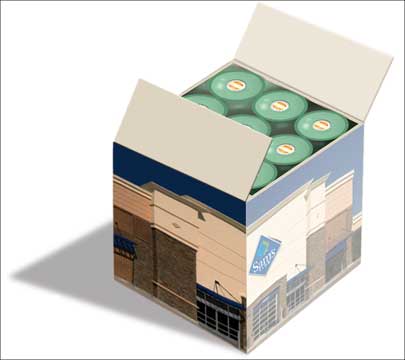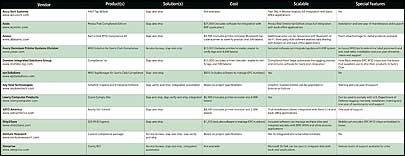Feb 01, 2009Sam's Club, the wholesale division of Wal-Mart Stores, asked its suppliers to tag pallets with ultrahigh-frequency RFID tags based on EPCglobal's Electronic Product Code standards beginning on Jan. 31, 2008. Suppliers that failed to do so would be charged $2 (or more) per pallet because Sam's Club would have to add the tags at its own distribution centers. Many suppliers chose the $2 route. Most suppliers that tagged their own pallets opted for the easiest and least expensive approach—"slap-and-ship," in which a label containing an EPC RFID tag with the correct serial number is manually placed on a case or pallet just before it's shipped.
Now Sam's Club suppliers are faced with another EPC RFID tagging mandate: Tag all "sellable units" that are bound for the wholesaler's DeSoto, Texas, distribution center by Oct. 31, 2009. And Sam's Club wants all of its suppliers to tag all sellable units by Oct. 31, 2010.
If you've taken the $2 or slap-and-ship route, you might not be worrying about how to meet these new tagging requirements. But you should be thinking about it—now. Tagging sellable units will require a lot more work than tagging pallets. Just how much work is involved will depend on how many stock-keeping units (SKUs) you ship to Sam's Club and in what quantities, as well as what kind of products you manufacture. Tagging items with metal or liquids will be more difficult than tagging, say, socks or bread.
October may be months away, but now is the time to put together a team to evaluate your company's processes and operations. This step is necessary to help you determine whether you'll approach the tagging requirements as the cost of doing business, or take additional steps to offset the cost by achieving internal benefits. That involves moving beyond slap-and-ship and integrating the RFID tagging system with your back-office applications to, for example, reduce out-of-stocks, optimize inventory management and improve order reconciliation.
The good news is that even if you haven't been thinking about how to meet Sam's Club's tagging requirements, a number of RFID vendors have. They've developed a variety of solutions—from slap-and-ship products to more complex packages that enable you to automate the tagging process—designed specifically to help Sam's Club suppliers become compliant. Some products will enable you to get up to speed quickly with a slap-and-slip tagging solution and then evolve into a more integrated system.
Here are some of the issues you should consider when choosing an EPC RFID tagging solution. Once you determine which approach best meets your company's needs, check out the table on page 32 to see which vendors offer that solution.
The least expensive solution is to use a service bureau, which will encode and print the EPC RFID tags for you and send them to your facility. You won't have to purchase any equipment. The cost is based on the number of tags you need.
Slap-and-ship solutions enable suppliers to place EPC RFID tags on products just before they ship them to Sam's Club. An off-the-shelf package requires little capital investment and generally includes a printer/encoder to generate EPC RFID labels, an interrogator to verify tag readability and a certain number of labels. Some of these solutions can also be used to meet EPC RFID tagging mandates from other retailers and the U.S. Department of Defense.
Click here to view a larger version of the image.
Slap-verify-and-ship solutions are similar to the slap-and-ship option, but you can use the EPC RFID tags to verify that the shipment matches the purchase order. This can reduce chargebacks and invoice deductions.
Suppliers should consider these options if they view meeting the tagging mandate as a cost of doing business and don't intend to use EPC RFID in a more strategic way. Both are labor-intensive, because you'll need to separate your inventory and apply the tags manually. Also, you won't be able to use any EPC RFID data to achieve internal benefits to offset the cost of tagging. These solutions make sense for companies that ship small volumes of products to Sam's Club, have limited resources for more extensive RFID systems, or need to become compliant quickly.
The slap-and-ship approach will become more costly and more difficult to manage as the number of units, SKUs and facilities increases. If you decide to start with a slap-and-ship package, ask the vendor whether it will allow you to evolve to a more integrated and/or automated solution, and if so, what will be involved, including cost, software, technical know-how, training and support.
These options—which range from integrated to automated tagging and end-to-end integration—make sense for companies that manufacture several SKUs shipped to Sam's Club from one or more locations. The possible benefits depend on the approach you adopt.
Integrated tagging: The EPC RFID system flags Sam's Club orders and automatically prints labels, which are applied manually. This approach reduces the labor costs associated with rehandling products and enables you to ramp up your tagging operations if needed. But the benefits won't offset the up-front investment.
Automated tagging: This approach—which can be done inline or offline—integrates order management on the back end and automates the process of applying EPC RFID tags to products. It reduces the labor costs and disruption to shipping processes, and enables you to ramp up your tagging operations. And it requires an up-front investment in IT integration.
End-to-end integration: This approach automates the tagging process and uses the tagging data provided by Sam's Club to improve product replenishment, inventory management and other internal business processes. While it will deliver the most benefits, it requires more up-front investment in equipment and IT integration.
EPC RFID-enabled boxes: Another option is to purchase corrugated cases that have a tag embedded inside the box. Before, after or while workers fill the case, an EPC can be generated by your back-end system and written to the tag. This eliminates the need to make capital investments in RFID equipment to print and apply the RFID tags, according to Domino Integrated Solutions, an RFID vendor that offers this solution. Some corrugate suppliers also offer this option as a value-added service. But it could be costly if you ship large volumes to Sam's Club.
Does the system integrate with your enterprise resource planning application? If so, how? Some products can be integrated with back-end applications from multiple vendors, while others are designed to work with specific programs from, say, Microsoft, Oracle or SAP. The same question applies to your warehouse management system and other back-office applications, such as an electronic pedigree software package you might be using to track pharmaceutical products.
How easy is the system to set up? Some systems include installation wizards with successive screens to guide you in entering all of the information needed for configuration. Ask if the wizard will help you configure your hardware and software, including the printer/encoder, fixed and/or handheld readers, label sizes and networks.
What kind of support does the vendor provide? Most companies will need some level of help with their EPC RFID implementation. If your organization requires expertise, be sure the vendor provides the needed services or can recommend a third-party partner that's knowledgeable about the EPC RFID system you're purchasing. In particular, ask about installation, training, maintenance and ongoing support.
Some suppliers believe that Sam's Club will back off from its requirement to tag sellable units. But while there may be some flexibility in the deadlines, it's more likely that Sam's Club will go forward with the tagging mandate because it will deliver a competitive advantage. Smart suppliers will start exploring their options for becoming compliant cost-effectively and with the least disruption to their operations.
Your tagging options will likely evolve as the deployment scales. For instance, in the first stage of the deployment, it might make sense to slap and ship from your own distribution center. But as you need to tag more units for additional DCs and stores, you might want to automate EPC RFID tagging. There are different strategies—inline or offline—for automating the tagging process. To help you decide which one might be best for your company, here's an excerpt from RFID Journal's The Complete Guide to Meeting Sam's Club's EPC RFID Tagging Requirements. (To learn more about this 120-page, illustrated, step-by-step guide to becoming compliant cost-effectively, visit www.rfidjournal.com/samsguide.)
Automated Offline Tagging
If you're concerned about disrupting your manufacturing line but want an automated approach to tagging, it might be possible to place the tag on or within the packaging before it enters the production line. If you use a machine to automatically open flat corrugated boxes for packing, there might be an opportunity to place the tag on the box during this process. Or, if you insert a sleeve of information into a package, it might be possible to place a tag on that sleeve prior to its insertion. Alternatively, the tag could be placed on the package after the production process is complete—for instance, when the package is sealed.
When it makes sense to employ this option depends on your current business processes. Is there a step in the handling of packaging where the tag could be applied without disruption? And can the process be isolated for stock-keeping units (SKUs) shipped to Sam's Club? If so, this might be your best option.
The major benefit of this option is that it reduces disruption to the manufacturing process, making it easier to remove a bad tag. When a bad tag is identified on a high-speed line, the applicator can miss the next two boxes while rejecting the bad tag. If you encode the tag and apply it to the packaging before it gets to the line, often you can check that the tag is working properly—and if not, you can remove it before it gets to the line. This approach also requires little ongoing investment in labor and is highly scalable. The downside is that it requires a significant up-front investment in equipment and integration work.
Automated Inline Tagging
You can place a high-speed label applicator on your manufacturing line so that as the product nears the end of the line—usually when a case is packed—a label is applied and encoded.
If your manufacturing line is fairly slow (say, 20 to 30 units per minute), the product's shape makes it easy to apply the tag, and you have no options for tagging offline, it might make sense for you to integrate the tagging operation into your manufacturing line.
As with tagging offline, this approach requires just a small ongoing investment in labor and is the most scalable. For faster lines, though, it might be difficult to apply, encode and check the tag without slowing down the manufacturing line. In addition, this approach requires the largest up-front investment in equipment and integration work—and there's also a risk that problems with the tagging equipment could disrupt manufacturing.


